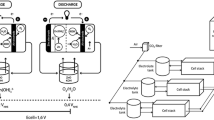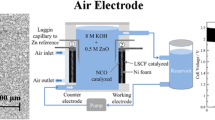Abstract
The effects of anode orientation (whether an anode is located above or under a cathode) and flow channel design (parallel or serpentine flow channel) on the performance of refuelable zinc-air fuel cells (RZAFC) continuously fed with KOH electrolyte were investigated. The performance test was conducted at different electrolyte flow rates of 2, 4, and 6 ml h−1. A polarization test of the cell was conducted at the initial stage of operation, followed by a long-term current discharge test in potentiostatic mode. The spent zinc powders were characterized by a scanning electron microscope and X-ray diffraction. The experimental results revealed that the anode-bottom orientation in the cell performed much better than the anode-top orientation with 11.4 times higher zinc utilization. The performance reduction of the anode-top orientation cell was caused by the cathode overpotential, due to the flooding of the cathode by water crossover from the anode, which was induced by the gravity force. For the flow channel design effects, there was an optimum electrolyte flow rate, to yield a maximum current discharge capacity, of 4 ml h−1 in this study. At this optimum flow rate, the total charge per gram of zinc delivered from the anode serpentine cell was 1.75 times higher than that from the anode-parallel one.












Similar content being viewed by others
References
Lee JS, Kim ST, Cao R, Choi NS, Liu M, Lee KT, Cho J (2011) Metal-air batteries with high energy density: Li-Air versus Zn-Air. Adv Energy Mater 1:34–50
Zhang XG (2006) Fibrous zinc anodes for high power batteries. J Power Sources 163:591–597
Stuart I, Smedley X, Zhang G (2007) A regenerative zinc-air fuel cell. J Power Sources 165:897–904
Goldstein J, Brown I, Koretz B (1999) New developments in the electric fuel Ltd. zinc/air system. J Power Sources 80:171–179
Neburchilov V, Wang H, Martin JJ, Qu W (2010) A review on air cathodes for zinc-air fuel cells. J Power Sources 195:1271–1291
Pei P, Ma Z, Wang K, Wang X, Song M, Xu H (2014) High performance zinc air fuel cell stack. J Power Source 249:13–20
Sapkota P, Kim H (2009) Zinc-air fuel cell: a potential candidate for alternative energy. J Ind Eng Chem 15:445–450
Jiricny V, Siu S, Roy A, Evans JW (2000) Regeneration of zinc particles for zinc-air fuel cells in a spouted-bed electrode. J Appl Electrochem 30:647–656
Hayre O, Cha SW, Colella W, Prinz FB (2009) Fuel cell fundamentals, 2nd edn. Wiley, Hoboken
Yang H, Zhao TS, Ye Q (2005) In situ visualization study of CO2 gas bubble behaviour in DMFC anode flow fields. J Power Sources 139:79–90
Oliveira VB, Rangel CM, Pinto AMFR (2010) Effect of anode and cathode flow field design on the performance of a direct methanol fuel cell. Chem Eng J 157:174–180
Szczesniak B, Cyrankowska M, Nowacki A (1998) Corrosion kinetics of battery zinc alloys in electrolyte solution. J Power Sources 75:130–138
Yap CK, Tan WC, Alias SS, Mohamad AA (2009) Synthesis of zinc oxide by zinc-air system. J. Alloys Compd 484:934–938
Cho YD, Fey GTK (2008) Surface treatment of zinc anodes to improve discharge capacity and suppress hydrogen gas evolution. J Power Sources 184:610–616
Acknowledgments
The authors would like to acknowledge the financial support of the National Research Council of Thailand (NRCT), and the Higher Education Research Promotion and National Research University (NRU) Project of Thailand, Office of the Higher Education Commission, and the Department of Chemical Engineering, King Mongkut’s University of Technology Thonburi (KMUTT).
Author information
Authors and Affiliations
Corresponding author
Rights and permissions
About this article
Cite this article
Jiratchayamaethasakul, C., Srijaroenpramong, N., Bunyangyuen, T. et al. Effects of anode orientation and flow channel design on performance of refuelable zinc-air fuel cells. J Appl Electrochem 44, 1205–1218 (2014). https://doi.org/10.1007/s10800-014-0737-4
Received:
Accepted:
Published:
Issue Date:
DOI: https://doi.org/10.1007/s10800-014-0737-4




